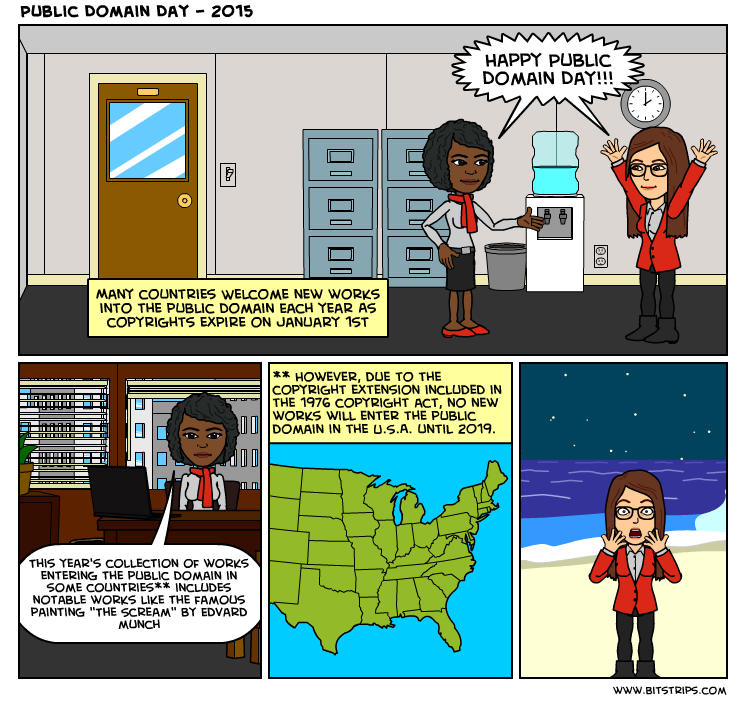This post highlights articles published in the last six months with a focus on copyright, especially as it pertains to libraries, higher education, and scholarly communication. Links to the full-text articles are provided when available; [OSU full-text] links will connect authenticated users through The Ohio State University Libraries, while [OA full-text] links point to an open access version of the article that should be available to all users.
Did we miss an interesting article? Please share the citation in the comments!
Copyright
Abdenour, J. (2014). Documenting fair use: Has the statement of best practices loosened the fair use reins for documentary filmmakers? Communication Law & Policy, 19(3), 367-398. [OSU full-text]
Collins, S. (2014). YouTube and limitations of fair use in remix videos. Journal of Media Practice, 15(2), 92-106. [OSU full-text]
Cowart, T. W., Gershuny, P., & Hawk, G. B. (2014). A survey of state copyright law. Southern Law Journal, 24(2), 311-335. [OSU full-text]
Glushko, R., Graham, R., Ludbrook, A., & Martin, H. (2014). Understanding “large and liberal” in the context of higher education. Feliciter, 60(4), 14-21. [OSU full-text]
Heald, P. J. (2014). How copyright keeps works disappeared. Journal of Empirical Legal Studies, 11(4), 829-866. [OSU full-text]
Hua, J. J. (2014). Construction of digital commons and exploration of public domain. Journal of International Commercial Law & Technology, 9(3), 148-164. [OA full-text] / [OSU full-text]
Olson, K. K. (2014). The future of fair use. Communication Law & Policy, 19(4), 417-432. [OSU full-text]
Libraries
Anderson, R. (2014). Asserting rights we don’t have. Library Journal, 139(15), 12. [OA full-text]
Behnk, R. b., Georgi, K., Granzow, R., & Atze, L. (2014). Testing the HathiTrust copyright search protocol in Germany: A pilot project on procedures and resources. D-Lib Magazine, 20(9/10), 1. [OA full-text]
Dougan, K. (2014). “YouTube has changed everything”? Music faculty, librarians, and their use and perceptions of YouTube. College & Research Libraries, 75(4), 575-589. [OA full-text]
King, R. (2014). House of Cards: The Academic Library Media Center in the Era of Streaming Video. Serials Librarian, 67(3), 289-306. [OSU full-text]
McKinnon, L. l., & Helge, K. S. (2014). Copyright, open access and library instruction. Library Hi Tech News, 31(10), 13-16. [OSU full-text]
Owen, V. (2014). The librarian’s role in the interpretation of copyright law: Acting in the public interest. Feliciter, 60(5), 8-12. [OSU full-text]
Rodriguez, J. E., Greer, K., & Shipman, B. (2014). Copyright and you: Copyright instruction for college students in the digital age. Journal of Academic Librarianship, 40(5), 486-491. [OSU full-text]
Schopfel, J., Chaudiron, S., Jacquemin, B., Prost, H., Severo, M., & Thiault, F. (2014). Open access to research data in electronic theses and dissertations: An overview. Library Hi Tech, 32(4), 612-627. [OSU full-text]
Soltau, C., & Farrell, A. (2014). Copyright and the Canadian for-profit library. Feliciter, 60(6), 9-14. [OSU full-text]
Williams, L. A., Fox, L. M., Roeder, C., & Hunter, L. (2014). Negotiating a text mining license for faculty researchers. Information Technology & Libraries, 33(3), 5-21. [OA full-text]
Publishing & scholarly communication
Dawson, D. D. (2014). The scholarly communications needs of faculty: An evidence based foundation for the development of library services. Evidence Based Library & Information Practice, 9(4), 4-28. [OA full-text]
Dutta, G., & Paul, D. (2014). Awareness on institutional repositories-related issues by faculty of University of Calcutta. DESIDOC Journal of Library & Information Technology, 34(4), 293-297. doi:10.14429/djlit.34.5138 [OSU full-text]
Rahmatian, A. (2014). Make the butterflies fly in formation? Management of copyright created by academics in UK universities. Legal Studies, 34(4), 709-735. [OSU full-text]
———————————————————————————————————————————————————————-
By Jessica Meindertsma, Rights Management Specialist at the Copyright Resources Center, The Ohio State University Libraries








Recent Comments